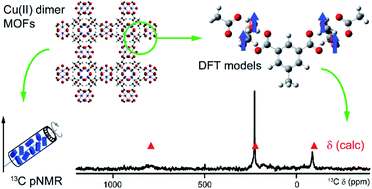Origin of the temperature dependence of 13C pNMR shifts for copper paddlewheel MOFs†
Abstract
An efficient protocol for the calculation of 13C pNMR shifts in metal–organic frameworks based on Cu(II) paddlewheel dimers is proposed, which involves simplified structural models, optimised using GFN2-xTB for the high-spin state, and CAM-B3LYP-computed NMR and EPR parameters. Models for hydrated and activated HKUST-1 and hydrated STAM MOFs with one, two and three Cu dimers have been used. The electronic ground states are low-spin and diamagnetic, with pNMR shifts arising from thermal population of intermediate- and high-spin excited states. Treating individual spin configurations in a broken symmetry (BS) approach, and selecting two or more of these to describe individual excited states, the magnetic shieldings of these paramagnetic states are evaluated using the approach by Hrobárik and Kaupp. The total shielding is then evaluated from a Boltzmann distribution between the energy levels of the chosen configurations. The computed pNMR shifts are very sensitive to temperature and, therefore, to the relative energies of the BS spin states. In order to reproduce the temperature dependence of the pNMR shifts seen in experiment, some scaling of the calculated energy gaps is required. A single scaling factor was applied to all levels in any one system, by fitting to experimental results at several temperatures simultaneously. The resulting scaling factor decreases with an increasing number of dimer units in the model (e.g., from ∼1.7 for mono-dimer models to 1.2 for tri-dimer models). The approach of this scaling factor towards unity indicates that models with three dimers are approaching a size where they can be considered as reasonable models for the 13C shifts of infinite MOFs. The observed unusual temperature dependencies in the latter are indicated to arise both from the “normal” temperature dependence of the pNMR shifts of the paramagnetic states and the populations of these states in the thermal equilibrium.



 Please wait while we load your content...
Please wait while we load your content...